Reptiles Help Teach Kids in the Classroom About Science
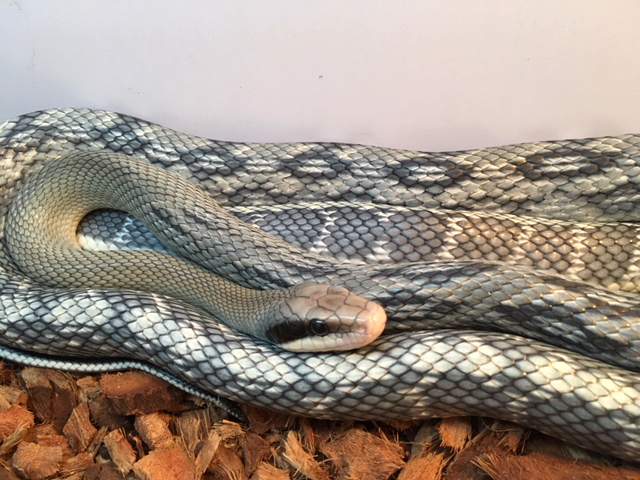
This female Vietnamese Blue Beauty Rat Snake (Orthriophis taeniurus callicyanous) is primarily a display animal in Mr. Tynes classroom, and used to get students excited and interested in the world of reptiles.
Friday night lights. Football, band, cheerleading, drill team, it’s what high school is all about. You can probably remember some fond memories of high school but more than likely they are of your friends, your sport, or a movie you saw in the theater, not what you did in your biology class.
However, as a high school science teacher, I work to make my class a memorable and educational experience. I do this by maintaining multiple species of reptiles inside my classroom at Forney High School, a 5A high school in Forney, Texas.
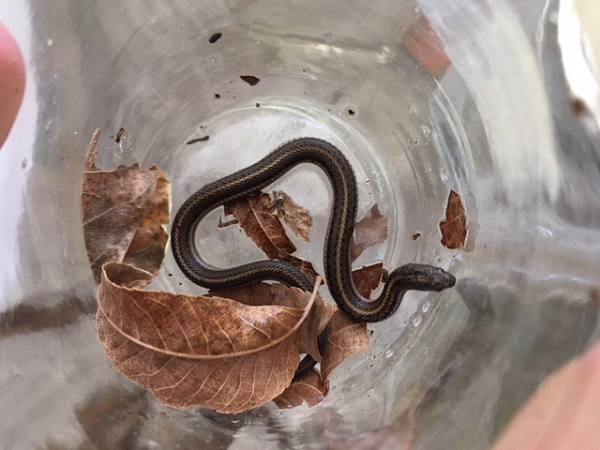
This Texas Lined Snake (Tropidoclonion lineatum texanum) was wild caught by a student of Mr. Tynes and brought into the classroom. After Mr. Tynes used the animal to teach his students about native reptile species and their role in the environment, his student took the animal home and returned it to his garden where it was discovered.
A History of Caring for and Learning from Reptiles and Amphibians
I am blessed to have an extensive background with reptiles growing up. My first job was at a pet store, where I maintained animal habitats and sold products to customers. Naturally, some of the reptiles and amphibians we sold at the store came home with me and by the time I was 16, I was breeding green anole lizards (Anolis carolinsis) and raising different species of tree frogs. My passion for reptiles continued as I pursued my bachelor’s degree in animal science at Texas A&M University- Commerce where I researched rat snakes and managed the reptile room of the campus Animal Care Facility. I stayed at TAMU-Commerce and obtained my masters of science in biology continuing to maintain the hundreds of reptiles in the research lab and study snake behavior. After that I worked in a snapping turtle and alligator lab at the University of North Texas while attaining my Masters of Education in Teaching. In addition to this work I have also worked with the reptiles and amphibians in the collection of the Children’s Zoo at the Dallas Zoo for the last 4 years. My wife and I also privately maintain a small collection of reptiles, which we breed when we have the time.
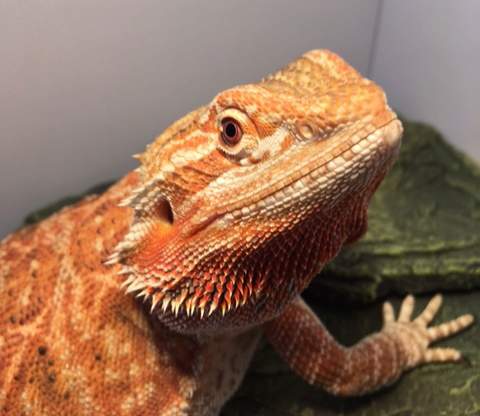
This female tangerine phase Bearded Dragon (Pogona vittceps), named Pumpkin by the students, was donated to Mr. Tynes by a student. She primarily serves as a calming animal, and when students are stressed or just need a few minutes to breath she is handled by them and this works to calm them. She seems to enjoy this as she is very personal and loves the attention.
Reptiles have always been a part of my life, so it was only natural for me to bring them into my classroom. Reptiles make for great classroom animals because of their ease of care and slow metabolism. The reptiles I have are very friendly and are under supervision while my students hold and feed them. For many students this is the first time they have touched a snake. Like most rural and suburban communities, snakes are feared and misunderstood in east Texas. So through the exposure of the snakes in my classroom, students learn that not all snakes are venomous and dangerous. They also serve as a discussion point for nearly every topic in biology and environmental sciences from ecology to genetics to anatomy.
The species I keep are varied and range from native Texas species like common snapping turtles (Chelydra serpentina) and diamondback water snakes, (Nerodia rhombifer) to exotics like Vietnamese blue beauty snakes (Orthriophis taeniurus callicyanous) and ball pythons (Python regius).
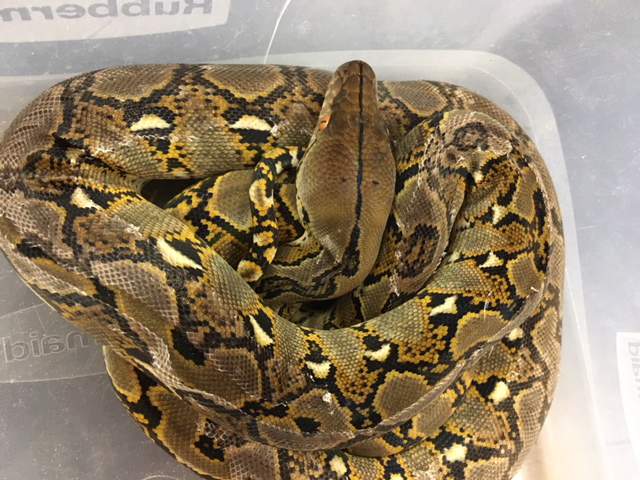
This young Reticulated Python (Python reticulatus) was rescued from an owner who did not possess the appropriate paperwork or knowledge to care for it. Upon receiving this animal Mr. Tynes was able to teach his students about animal regulations and some of the organizations that maintain the legality and integrity of the reptile industry and wild ecosystems.
The Classroom: A Loving Home for Reptiles, A Unique Opportunity for Students
My classroom also serves as a sanctuary for reptiles that no longer have a good home. On occasion, I will have students bring me unwanted pets or rescued animals. I use these new animals to educate my students on another species, general care of that species and natural history and ecology. We also reinforce hygiene as we discuss parasites and appropriately quarantine any new animal brought in.
In addition to assisting me with daily cleaning and feeding, my students occasionally watch the animals over holiday breaks. My students also provide 150 sets of eyes each day to evaluate the health of animals, so no physical or behavioral abnormality goes unnoticed.
Reptiles also provide me with contacts beyond the classroom that I can share with my students for future academic and career opportunities. I teach Herpetology as an adjunct professor for a local university and assist in reptile related wildlife and criminal court cases through local agencies. I have two major projects with students throughout the year to reinforce and teach biology concepts. I use a medium size collection of Colubrids (the family of snakes) to assist in teaching genetics and I maintain a small collection of eyelash crested gecko’s (Rhacodactylus ciliatus) to teach about development and comparative physiology of vertebrates.
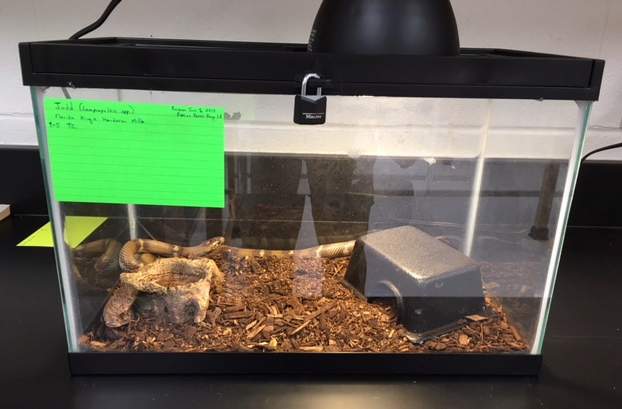
Pictured here is a unique hybrid, half Florida Kingsnake (Lampropeltis getula floridana) and half Honduran Milk Snake (Lampropeltis triangulum hondurensis). This Zilla 5-Gallon tank is cleaned and maintained by seniors in Mr. Tynes classroom. This unique animal allows for Mr. Tynes to explore to concept of “species” and concepts of reproduction like number of chromosomes.
Discovering Biology and Genetics with Living Reptiles
Through my experience teaching I have seen a trend where many biology students seem to be lacking in a fundamental understanding of genetics. This is seen in local and state standardized test scores as well as from observing students trying to learn it. The inability of students to fully grasp the concepts of how genetics work is a twofold problem. First, genetics is often presented in a boring manner via a PowerPoint lecture and extensive vocabulary work. Second, genetics in the classroom is not something typically taught hands-on in a lab due to financial constraints and/or lack of faculty expertise.
By using living animals as a tool in the classroom, I can visually teach students genetics and developmental biology. Genetics teach how specific traits and characteristics are passed down from one generation to another. And now we can trace individual genes (the genotype) through an analysis of the expression of that gene (the phenotype) live in our classroom the same way Scientist Gregor Mendel did. I am able to show the students development of the fetus that is growing inside the egg by candling the egg (placing a light source under it). We discuss how organisms develop inside an egg, going from one cell to trillions during development and the beginning of specific organs turning on, such as the heart.
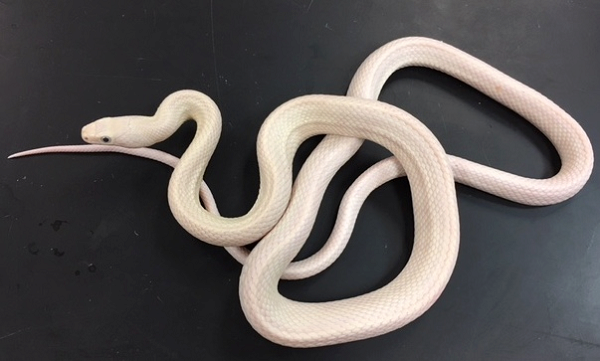
A leucistic Black Rat Snake (Pantherophis obsoleta) used in Mr. Tynes biology class to study behavior and genetics.
Rats snakes and corn snakes are universally used as research and study animals for their ease of care, small and convenient size, and vast color mutations. The genes that code for the scale colors and pattern types of these snakes have been discovered and many are expressed in visually different phenotypes such as black or white, striped, or patternless morphs. These genes are passed through complete, incomplete and codominance. Because of this we can account for specific genes and trace them from a parent to an offspring. By teaching the students how basic genetics of a trait works (like albino) students are able to pair parent reptiles together to estimate what their babies should look like and what the genetics of the offspring will be.
As a result of working with live breeding animals through hands on lab experiments, students are able to fully grasp the idea of how genotypes and phenotypes are passed to the subsequent generation. They are able to understand that the expression of a gene is regulated by many properties including environmental factors such as incubation temperature. By analyzing the resulting offspring students can recognize changes in the DNA of an animal by the phenotypes that the offspring have. The resulting offspring fortify the students' ability to estimate genetic outcomes and predict specific occurrences. I maintain a current collection of 20 intergrade rat snakes (Scotophis sp.) and Eastern corn snakes (Pantherophis guttatus guttatus) for the kids to study and learn genetics.
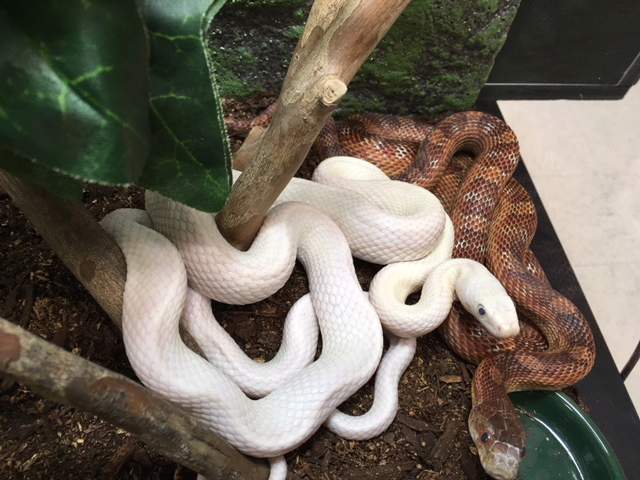
A leucistic Black Rat Snake (Pantherophis obsoleta) and a corn snake (Pantherophis guttatus) heterozygous for leucistic are cage mates, so students can visually see the difference between an organism that is homozygous for the leucistic gene compared to heterozygous. These snakes are also used to study the social behavior in den selection.
The Benefits of Learning with Live Reptiles
Crested geckos are a breed of reptiles that I have recently begun to use as research animals because of their ease of care, small and convenient size, and relatively quick reproduction rate. Reptiles have long been used as a research animal for developmental studies because of the similarities of their physiological development to that of humans. One male can breed with multiple females which can each produce a couple of large eggs. Incubation time on the eggs is temperature dependent and can be greatly altered by ambient temperatures. The eggs are strong yet easy to see through and the hatch rate on the eggs is relatively high. These easy to view eggs allow my students to see neonatal blood vessels and appendages being formed. Because of the convenient egg size, my students are also able to analyze egg oxygen consumption and carbon dioxide output in small changes (cellular respiration) through designed experiments.
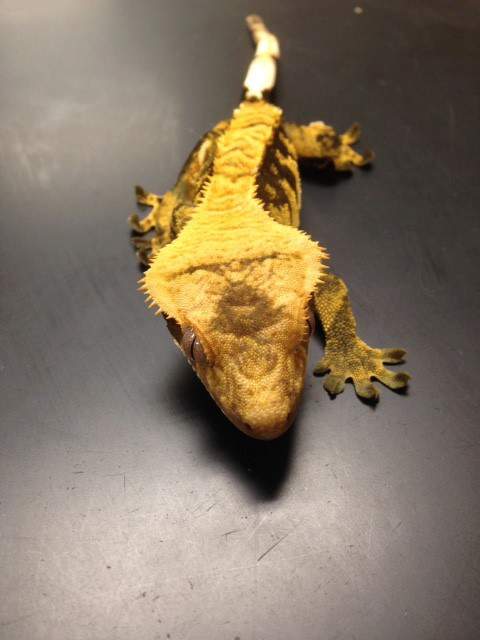
This male crested gecko (Correlophus ciliatus) is a part of the breeding program in Mr. Tynes classroom. Eggs produced provide the opportunity to discuss developmental physiology, babies produced provide the opportunity to discuss polygenic species, and students get the chance to build and design their own terrariums for these animals which are kept in Zilla Tropical Vertical Terrariums. (Front Opening Terrariums are also an option)
These are just some examples of the ways I have integrated the use of live reptiles in my classroom for educational purposes. I love being able to introduce my students to the unique and exciting world of herpetology and I am able to do this while teaching them the science material they need for their futures. These activities are made possible by the support of my administration, the students themselves, parents, the community, and corporate partners like Zilla products.
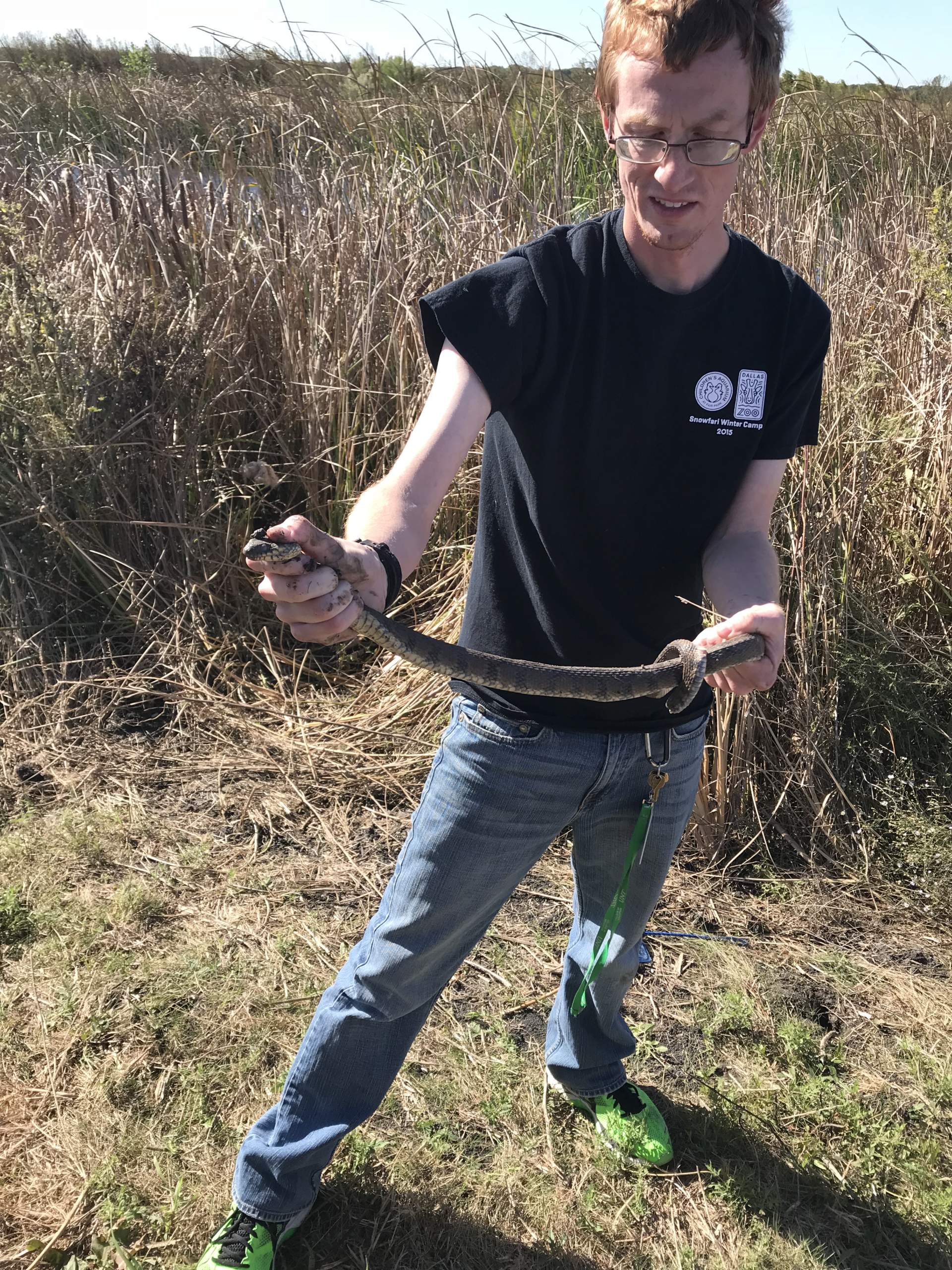
Jerrod in Texas holding a Diamond Back Water Snake (Nerodia rhombifer) which was wild caught by him on a field trip to a local wetland with his AP Environmental Science class. A unique teaching opportunity to discuss how the health of a wetland directly correlates to the species that can be found there. Once the teaching demo was over, and the wetland staff got some photos, the snake was released.
Jerrod G. Tynes, M.S. & M.Ed.
Science Teacher, Forney High School
Adjunct Professor, Texas A&M University- Texarkana
Educational Instructor, Dallas Zoo & the Children’s Aquarium at Fair Park
Urban Agriculture Consultant, University of North Texas at Dallas
Product provided free.

Jerrod Tynes and his wife Ashleigh Tynes exploring Cooper Lake State Park in East Texas.
Special Thanks,
I would like to say special thanks to my wife who allows me to pursue my reptile hobby and supports me in every way as a wife, reptile enthusiast, and fellow science educator. Thank you to Zilla products for this opportunity to tell my story and for all of their product support. Thank you to all of my other classroom sponsors and partners and thank you to my district for allowing me to educate my students in my unique way. If you have any questions or comments, are interested in supporting us at Forney High School or are an educator yourself please email me at jerrodtynes@gmail.com as I would love to communicate with any of Zilla product’s readers and reptile enthusiasts.
